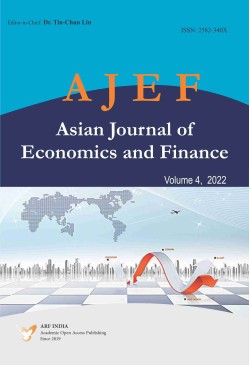
Asian Journal of Economics and Finance
Frequency :Quarterly
ISSN :2582-340X
Peer Reviewed Journal
Institutions and Efficiency of Public Finance Policy: An Empirical Approach
Evangelia Vasilarou & Ageliki Anagnostou (2024). Institutions and Efficiency of Public Finance Policy: An Empirical Appraoch. Asian Journal of Economics and Finance. 6(1), 1-19. https://
DOI: 10.47509/
AJEF.2024.v06i01.01
Sustainable Foreign Aid and Contracting External Debt: Growth Enhancing Effects and Policy Imperatives
Monetary Policy Transmission in Financial Markets: Evidence from the First Stage
Spatial and Vertical Market Integration and Price Transmission in the Ethiopian Banana Supply Chain
Impact of Stock Market Development on the Economic Growth of Pakistan
Catalyzing Sustainable Consumption Through Youth-driven Eco-preneurship: A Pathway for Innovation and Mindful Transformation
As India embarks on the ambitious Vikshit Bharat 2047 program, fostering sustainable consumption and production patterns is paramount to address environmental challenges and drive holistic development. This conceptual paper explores the role of ecopreneurship, entrepreneurship focused on environmental sustainability, as a catalyst for promoting youthdriven sustainable consumption and innovation. By reviewing literature on ecopreneurship and sustainable consumption, a theoretical framework is established, highlighting the importance of cultivating an ecopreneurial mindset, addressing challenges and opportunities, and building a supportive ecosystem. The paper underscores the need for integrating sustainability education, entrepreneurship training, incubation and acceleration programs, sustainable funding mechanisms, and collaborative platforms. By harnessing the energy, creativity, and passion of Indian youth through ecopreneurship, India can unlock the potential for driving sustainable consumption, fostering mindfulness, and nurturing sustainability consciousness, thereby contributing to the nation’s holistic development goals under the Vikshit Bharat 2047 program.
Aishwarya Soni & Ramulu Bhukya (2024). Catalyzing Sustainable Consumption Through Youth-driven Ecopreneurship: A Pathway for Innovation and Mindful Transformation. Asian Journal of Economics and Finance. 6(1), 99-111. https://DOI: 10.47509/AJEF.2024.v06i01.06